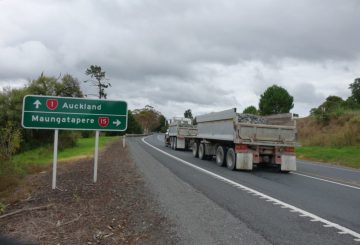Mawera Karetai và con trai Jack Karetai-Barrett được chuẩn bị kỹ lưỡng cho thiên tai, với những vật dụng sinh tồn được cất giữ trong ba lô ở nhà và trong xe của họ. Mawera, một nhà nghiên cứu địa phương, cảnh báo rằng Whakatāne, một thị trấn ở New Zealand, cần chuẩn bị cho một trận động đất lớn và sóng thần tương tự như sự kiện năm 2011 ở Nhật Bản.
Các nhà khoa học nghiên cứu Vùng chìm Hikurangi, ngoài khơi bờ biển phía đông của Đảo Bắc, dự đoán một trận động đất lớn có thể xảy ra trong vòng 50 năm tới. Có 25% khả năng nó có thể lớn bằng một trận động đất 9,1 độ richter. Mawera cảnh báo rằng một sự kiện như vậy có thể gây ra thiệt hại cơ sở hạ tầng lớn và cô lập, vì các nguồn lực sẽ được chuyển đến các thành phố.
Mawera đã tổ chức một loạt các hội thảo với các nhà địa chấn học từ GNS, một viện nghiên cứu địa chất, cho tháng tới. Cô tin rằng nhiều người trong thị trấn không chuẩn bị đầy đủ cho một trận động đất. Các hội thảo sẽ thảo luận về các đường đứt gãy khác nhau có nguy cơ, bao gồm cả vùng chìm bên dưới thị trấn. Những người tham dự nên rời đi với một kế hoạch hành động về cách giữ cho cộng đồng của họ an toàn.
Mawera đã nói chuyện với Hội đồng quận Whakatāne về mối lo ngại của cô rằng họ không có kế hoạch sơ tán cho thị trấn. Hội đồng đã nói rằng họ cam kết nâng cao nhận thức và hiểu biết của cộng đồng về giáo dục thiên tai.
Hội đồng đã bắt đầu làm việc trong một dự án đa cơ quan để phát triển các quy trình và thủ tục sơ tán mới đối với rủi ro sóng thần và lũ lụt. Họ cũng đang phát triển các Trung tâm Phòng vệ Dân sự trên toàn huyện để cung cấp các nguồn lực khẩn cấp sau một sự kiện nguy hiểm tự nhiên.
Các hội thảo là một phần của dự án nghiên cứu có tên “Our Changing Coast”, được tài trợ bởi Quỹ Endeavour của Bộ Kinh doanh, Đổi mới và Việc làm. Dự án điều tra các yếu tố như di chuyển đất và mực nước biển dâng trên các cộng đồng ven biển. Mawera đã được yêu cầu nghiên cứu những tác động đối với những người trẻ tuổi sống ở những khu vực này.
Các hội thảo được lên kế hoạch cho tuần cuối cùng của tháng Sáu. Tùy thuộc vào thành công của họ, chúng có thể được mở rộng đến tất cả các khu vực ven biển ở New Zealand.




























































